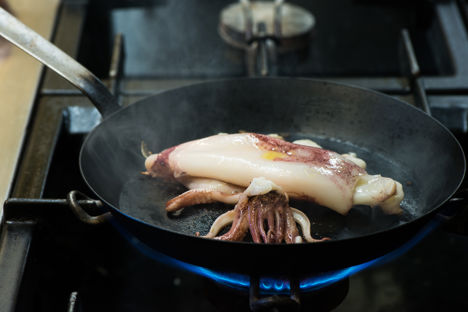From deep-fried calamari to stuffed squid or even a slow-cooked squid bolognese, there are many ways to enjoy this cephalopod. The trick with squid is to either cook it very quickly at a high temperature or very slowly at a low temperature – dither in between and you run the danger of ending up with a rubbery texture. Get it right though, and you will reap the rewards with a delicate taste and beautifully soft consistency.
There are lots of different varieties, but the squid most commonly found round the British Isles is the forbesi, with the loligo vulgaris found further south in the Mediterranean. Both are prepared the same way – separating the body from the tentacles, removing the quill and beak and then the wings. Pre-prepared squid is widely available in fishmongers and supermarkets year round, leaving little excuse not to embrace this seafood; cook it for mid-week meals as well as summer barbecues and celebratory dinners.
How to prepare squid
It's important to be clean and methodical when preparing a whole squid. Start by washing it thoroughly and then pulling away the tentacles. Next cut off the 'wings' and scrape the membrane away from the body. Finally, cut off the head just below tentacles and then the beak. It is difficult to describe this process so we have produced a video tutorial to help.
How to cook squid
Slow-cooking squid is a common technique in countries like Spain, Portugal and Italy where the white flesh is often braised for up to two hours. Usually the recipes start by frying shallots and garlic, then briefly tossing the squid in the pan before covering everything with stock or wine and adding other ingredients – often tomatoes and peppers. The temperature is set to a gentle simmer until the squid is beautifully tender. Slow-braised squid dishes like this are usually served with a hunk of bread.
For a twist on this technique, Pierre Koffman has developed a recipe for Squid bolognese using squid mince, while Martin Wishart follows a more conventional method in his recipe for Squid braised in red wine and tomato, cooking the squid tubes under a cartouche for 90 minutes.
At the other end of the scale is squid sashimi which doesn't require any cooking at all or squid ceviche in which the flesh is ‘cooked’ by the acidity of lemon or lime. Another quick method for cooking squid is simply to char-grill it or sautéed in olive oil. Very quickly, the squid will turn an opaque, brilliant white which means that it is cooked.
As squid is prized for its distinctive texture and delicate taste, chefs have started sneaking it in more and more recipes. Shaun Rankin adds squid to a potato salad, while Simon Hulstone mixes strips of squid into his mackerel burger mix and Martin Wishart uses the delicate flavour to accompany his pork.
What squid goes with
The simplest serving is a lone segment of lemon, though sauces like aioli or tartare are also great additions to a plate of squid. Simon Hulstone stirs a dash of smoked paprika through the mayonnaise he adds to his mackerel and squid burger, and Adam Stokes uses a rosemary mayonnaise to serve alongside his squid cornets.
Chinese 'salt and pepper squid' is one of the most popular squid recipes. Louder flavours like chilli and 'nduja also bring a welcoming kick to a bowl of pan-fried or battered squid. For more inspiration, look to the Mediterranean pantry; oven-dried tomatoes, chorizo or a bouillabaisse sauce all enhance the delicate flavour of squid.
Get in touch
Please sign in or register to send a comment to Great British Chefs.



